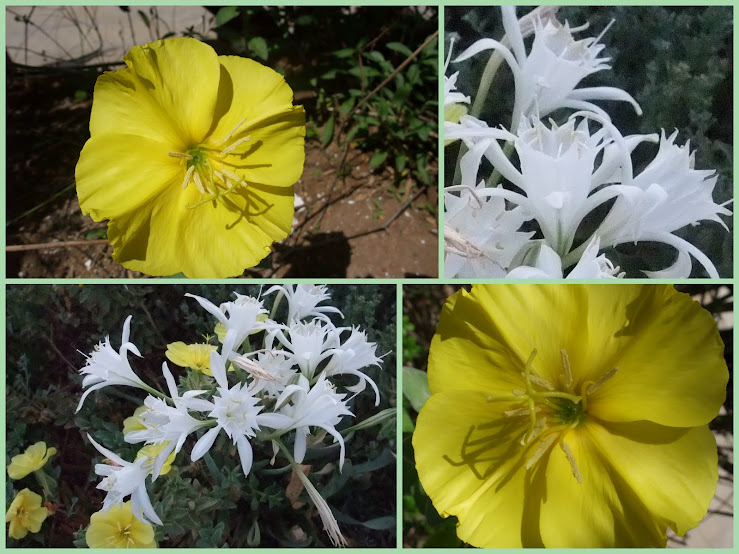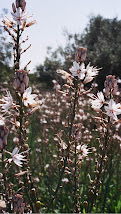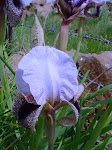Anemones come in many colours beside red

- here are some beautiful lilac ones
Tuvia's iris
Beautiful
The rarest of irises
In the last few weeks I have had the good fortune to visit both the Golan and the Negev. In both places, surprisingly enough, I saw wild irises in bloom.
In 1948 the ill-fated Lamed Hey were ambushed in the Ela valley as they tried to come to the aid of the besieged defenders of Gush Etzion. One of the 35 young heroes who gave his life that day was Tuvia Kushnir.
All his too short life he was a lover of flowers and had gone on many a field trip seeking them out. On one such trip, he wandered into Jordan and was arrested by the Jordanians, as they thought he was a spy. Who would believe that an Israeli would stray into Jordan looking for a flower? But they did, and he was released unharmed.
Tuvia discovered an iris that at first was thought to be the Irus Eretzisraeli or Iris palaestina but it turned out to be a much rarer relative, unique to Israel. This beautiful and rare flower is found in the wilds of the Negev desert north of Mitzpeh Ramon.
To my immense joy, I found and photographed one at Borot Lotz, not far from a desert cystern dug three thousand years ago by the Children of Israel.
The swamp iris

What an intricate flower the Grant Duff's iris is.
Egg yolks

Lovingly encircled
Monday, November 16, 2009
A delightful trip to the Birya forest
Over 40 intrepid souls set off this week on a trek to see the splendid "Chelmonit". We would walk 13 kms up, and luckily mostly down Mount Canaan, through the Birya forest, and along the woodland tracks down to Rosh Pinna in the hopes that this elusive yellow flower would be flowering.
The Hebrew name refers to the fact that the flowers look from a distance as if someone has smashed egg yolks on the ground! No leaves, barren earth all around,the Sternberger clusiana is a dramatic site to behold.
As you can see from the photos we succeeded in our quest - these lovely blooms were discovered just a kilometre from the end of our trek!
They were well worth the wait!
We Israelis love our wild flowers and will travel long distances to see them. A delightful tradition has grown up around the Sternbergia. Perhaps someone noticed that the delicate flower was being trampled by the very enthusiasts who had set out to view it, and so he or she decided to protect it! Now you can often find the flowers surrounded by a ring of stones. Look in the picture above and you'll see the circle.
By the way, the Sternbergia has its own defences. The winter months are not the optimum time for being pollinated. So it has two clients! Honey bees collect nectar and pollen from the shorter inner whorl of stamens. The hover flies visit the outer appendages and the longer stamen whorl.
Our Sternbergia is a genus of the Amaryllidaceae family. Although it looks a bit like a crocus, it is more closely related to the narcissus.
The Hebrew name refers to the fact that the flowers look from a distance as if someone has smashed egg yolks on the ground! No leaves, barren earth all around,the Sternberger clusiana is a dramatic site to behold.
As you can see from the photos we succeeded in our quest - these lovely blooms were discovered just a kilometre from the end of our trek!
They were well worth the wait!
We Israelis love our wild flowers and will travel long distances to see them. A delightful tradition has grown up around the Sternbergia. Perhaps someone noticed that the delicate flower was being trampled by the very enthusiasts who had set out to view it, and so he or she decided to protect it! Now you can often find the flowers surrounded by a ring of stones. Look in the picture above and you'll see the circle.
By the way, the Sternbergia has its own defences. The winter months are not the optimum time for being pollinated. So it has two clients! Honey bees collect nectar and pollen from the shorter inner whorl of stamens. The hover flies visit the outer appendages and the longer stamen whorl.
Our Sternbergia is a genus of the Amaryllidaceae family. Although it looks a bit like a crocus, it is more closely related to the narcissus.
Subscribe to:
Post Comments (Atom)
The glorious Poleg irises

This area of the Netanya cliffs is slated to disappear beneath a housing development. But the area alongside will be saved. And willing volunteers are lovingly digging up and replanting the iris rhizomes in the protected place.




















No comments:
Post a Comment